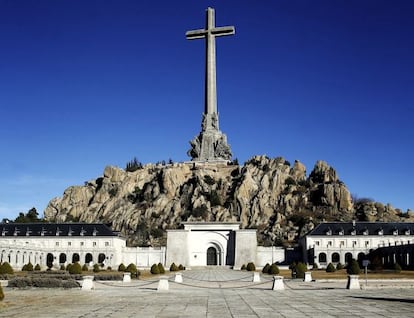Court mulling first exhumation at Valley of the Fallen monument
Relatives of two Civil War victims file suit to analyze bones at site of Franco’s tomb


For the first time ever, the Spanish courts have been presented with a civil lawsuit demanding the exhumation of bodies from the Valley of the Fallen, the enormous Francoist monument outside Madrid where over 30,000 victims of Spain’s Civil War dead lie buried.
Purificación Lapeña Garrido, whose grandfather and great-uncle were executed by General Francisco Franco’s forces at the beginning of the Civil War (1936-1939) and allegedly buried in the Valley of the Fallen, is trying to recover their remains through legal channels.
It’s about recognizing a family’s right to bury their grandfather wherever they wish”
Eduardo Ranz, plaintiff's lawyer
A judge in El Escorial, the municipality in which the huge mausoleum – whose 152-meter-high cross makes it visible from miles around – has taken statements from relatives of the victims as a preliminary step in the investigation.
Manuel Lapeña, a veterinary inspector, and his younger brother Antonio, a blacksmith, were arrested in July 1936 in Villarroya de la Sierra, a village near Calatayud (Zaragoza). Their family was among the founding members of the local branch of the CNT anarchist trade union.
According to his granddaughter, Manuel was “pulled out” of prison by members of the right-wing Falange, shot dead at a ravine known as La Bartolina, outside town, and buried in a mass grave in the same area.
His brother initially escaped but later turned himself in, serving a short time in prison, before he was shot against a cemetery wall and left in another mass grave.
In 1959, the Governance Ministry – the predecessor of today’s Interior Ministry – transferred the remains of several graves to the Valley of the Fallen, which was later to become Franco’s own final resting place. Among these were all the bodies found in and around Calatayud.
There is a certificate from the Benedictine abbot of Cuelgamuros stating that the remains from that particular part of Spain were deposited inside a specific niche at the Valley of the Fallen.
The relatives of both victims have used this document to support their legal claims to the bodies. The authenticity of the paperwork has not been questioned.
Now Purificación Lapeña wants the court to allow the exhumation of the niche’s remains, which would then undergo DNA testing to see if any of the bones belong to her grandfather or great-uncle.
The plaintiff also wants to legally change the official documents describing her relatives as criminals, and instead have them state that both men were killed because of their ideas.
Before the case moves on any further, the plaintiffs have 30 days to prove that the common graves in Calatayud contain no more human remains. The family is hoping that the court will reach a decision by Christmas.
“It’s about recognizing a family’s right to bury their grandfather wherever they wish,” says the family lawyer, Eduardo Ranz. “The state has to pay for this, because it is responsible for the victims’ execution and for their transfer to the Valley of the Fallen.”
English version by Susana Urra.
Tu suscripción se está usando en otro dispositivo
¿Quieres añadir otro usuario a tu suscripción?
Si continúas leyendo en este dispositivo, no se podrá leer en el otro.
FlechaTu suscripción se está usando en otro dispositivo y solo puedes acceder a EL PAÍS desde un dispositivo a la vez.
Si quieres compartir tu cuenta, cambia tu suscripción a la modalidad Premium, así podrás añadir otro usuario. Cada uno accederá con su propia cuenta de email, lo que os permitirá personalizar vuestra experiencia en EL PAÍS.
¿Tienes una suscripción de empresa? Accede aquí para contratar más cuentas.
En el caso de no saber quién está usando tu cuenta, te recomendamos cambiar tu contraseña aquí.
Si decides continuar compartiendo tu cuenta, este mensaje se mostrará en tu dispositivo y en el de la otra persona que está usando tu cuenta de forma indefinida, afectando a tu experiencia de lectura. Puedes consultar aquí los términos y condiciones de la suscripción digital.
Últimas noticias
The brief rise and retreat of Generation Z in Mexico
A floating school teaches children how to save Lake Atitlán
Pablo Escobar’s hippos: A serious environmental problem, 40 years on
From Andorra to Gibraltar, a black market for Ozempic exploits its success: ‘They’re the most sought-after products in the world’
Most viewed
- Why we lost the habit of sleeping in two segments and how that changed our sense of time
- Charles Dubouloz, mountaineering star, retires at 36 with a farewell tour inspired by Walter Bonatti
- Venezuela faces its most tense Christmas yet
- Trump’s obsession with putting his name on everything is unprecedented in the United States
- CBS in crisis after pulling a report on Trump’s deportations to El Salvador (which later leaked online)








































